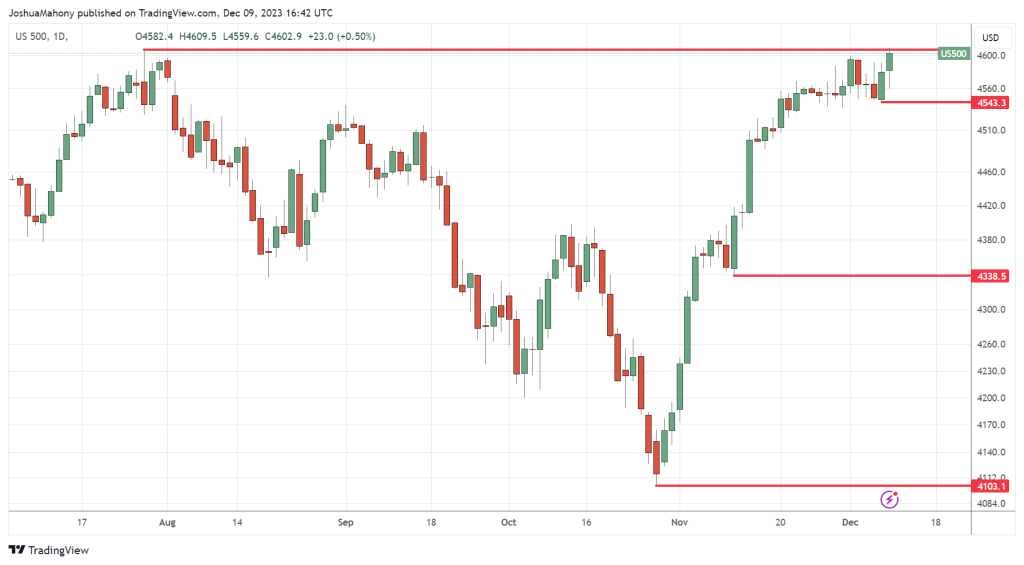US CPI preview: will energy declines help drive further disinflationary optimism?

Markets are bracing themselves for plenty of volatility with Tuesday’s latest US CPI inflation release due out just one day prior to the FOMC interest rate decision. Markets appeared to have taken a somewhat sanguine approach to December following an overwhelmingly positive month of November that saw a significant shift in expectations around the potential timing and pace of the Federal Reserve’s monetary policy pivot. However, the caution being felt in the lead up to this pivotal week does highlight the potential for volatility should the data or FOMC outlook failed to confirm the growing expectations for next year.
What do markets currently expect?
The Federal Reserve warning that they plan to keep interest rates higher for longer falling on deaf ears, with markets instead look for a swift and timely return to ’normal’ rates next year. The view a month ago was that we would most likely see a sum total of three to four cuts beginning in June. Things have come on a long in that time, with markets now expecting 125-basis points worth of rate cuts beginning in March.

The question for many is whether this is justified, with the September dot plot laying out a very different outlook according to the expectations of FOMC members. The 125-150-basis points worth of 2024 cuts currently anticipated by markets is an outlier option according to that September view. With that in mind, markets need to either see the Fed shift their stance, or else markets need to realign their views to better reflect the thinking of the FOMC.

Inflation
With markets increasingly upbeat over the prospects of a huge raft of rate cuts next year, we need to see inflation continue its downward trajectory too maintain that confidence going into next year. A deep dive into the metrics highlight the potential outlook for this coming release, with the -0.5% eurozone figure likely to provide encouragement that we could see an energy driven decline this time around. A look at the monthly breakdown highlights the 0.2% monthly figure from November, meaning that we will essentially need to see minimal or negative monthly inflation to drive down the annual rate. The decline in energy does highlight the potential for a decline this time around, but the bulk of the move looks likely to come when the January (0.52%) and February (0.37%) figures drop out in February and March. With the headline rate currently standing at 3.2%, there is a good chance that the next two releases see inflation either flat or marginally lower, with the move towards target only happening in two months onwards.
The 8-month annual figure (current outlook for the March meeting) highlights how we need to see last month’s minimal monthly figure (0.045%) replicated if we are head back towards target, with August (0.6%) and September (0.4%) alone amounting to half the annual target. For now the decline energy allows us to make headway towards target, but another monthly surge would really set back the outlook for a return to target.

Core CPI looks to be more a problem, with the road back to target a slow and steady affair. By stripping out volatile factors like energy and food, the FOMC are provided with a more relevant reading that reflects elements they can directly affect through monetary policy. The gradual decline in both core CPI (4%) and core PCE (3.5%) inflation metrics point towards a very low likeliness that they will return to target by March. By utilising the 8 month annualised figure as a proxy for the annual rate by March, we are likely to be closer to 3% that 2% in the Fed favoured core PCE metric. It will be key to watch out for the Fed’s view on whether they perceive a return to target for headline inflation as sufficient to begin the process of lowering rates.

Looking ahead to this month’s inflation reading, things looked like they could become tough as base effects stifle the continued disinflation pathway and core CPI continues to slowly drift lower. That may be affected by the slump in energy prices, with the continuation of the move towards target key to driving market sentiment. The recent strong payrolls data proved to provide only a fleeting negative impact on market sentiment, with equity markets soon gaining ground. Coming into an election year, there is going to be a desire to help the economy by cutting rates once inflation allows it. The question of whether inflation will get down to target quick enough to justify the current market expectations is another matter. A monthly surge in US CPI would be a big problem given the 1% amounted between August and September alone. For now that seems unlikely, with the decline in oil helping bolster the idea that the US will benefit in a similar manner to the eurozone when they reported their -0.5% November figure. The chart below highlights how the downward trajectory seen over the course of November does highlight the potential for a negative or flat monthly CPI figure following the October 0.045% reading. That could help drive headline inflation lower, while core inflation looks likely to remain somewhat stagnant as it attempts to grind lower.

S&P 500 technical analysis
The S&P 500 has continued its optimistic surge last week, with the pullback towards the 4537 swing low ultimately seeing price turn upwards and maintain the trend of higher lows. The subsequent push has taken price back up towards the 4606 peak, with a push through resistance needed to continue the bullish momentum. A notable decline in the US inflation gauge would likely help push the index higher yet, with a decline through 4543 support required to negate this current bullish trend.

Disclaimer: This material is a marketing communication and shall not in any case be construed as an investment advice, investment recommendation or presentation of an investment strategy. The marketing communication is prepared without taking into consideration the individual investors personal circumstances, investment experience or current financial situation. Any information contained therein in regardsto past performance or future forecasts does not constitute a reliable indicator of future performance, as circumstances may change over time. Scope Markets shall not accept any responsibility for any losses of investors due to the use and the content of the abovementioned information. Please note that forex trading and trading in other leveraged products involves a significant level of risk and is not suitable for all investors.







